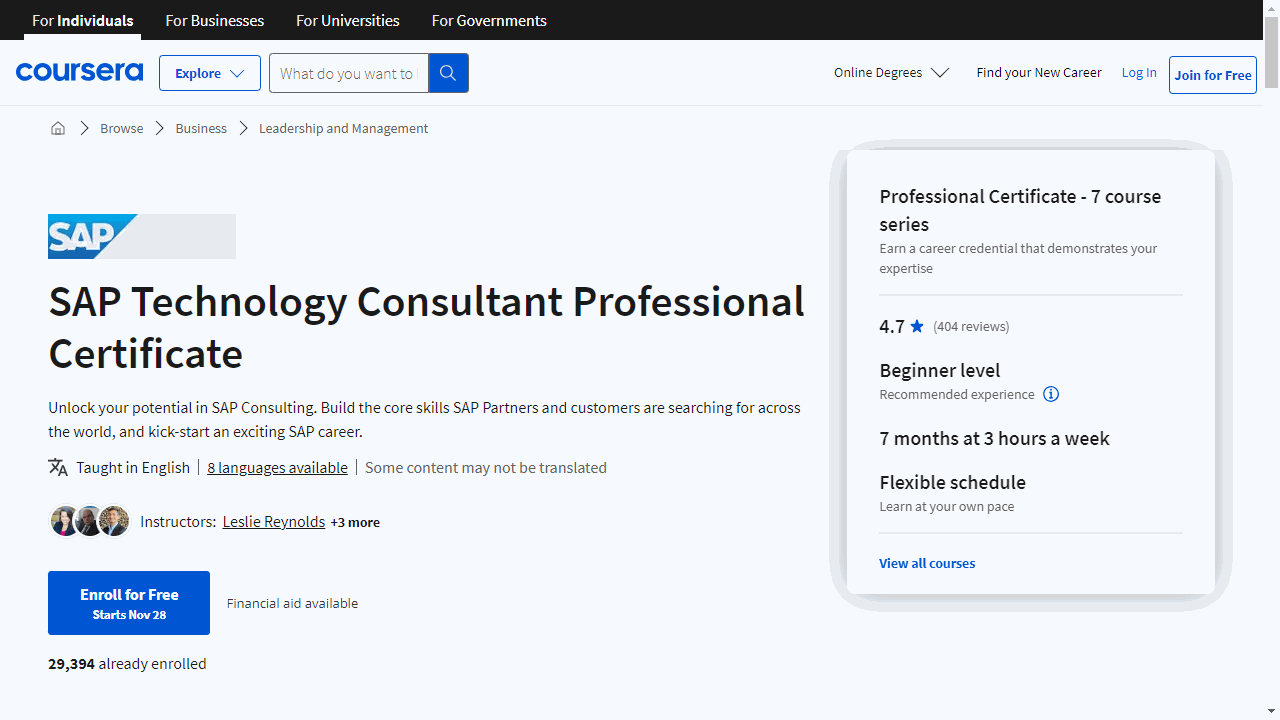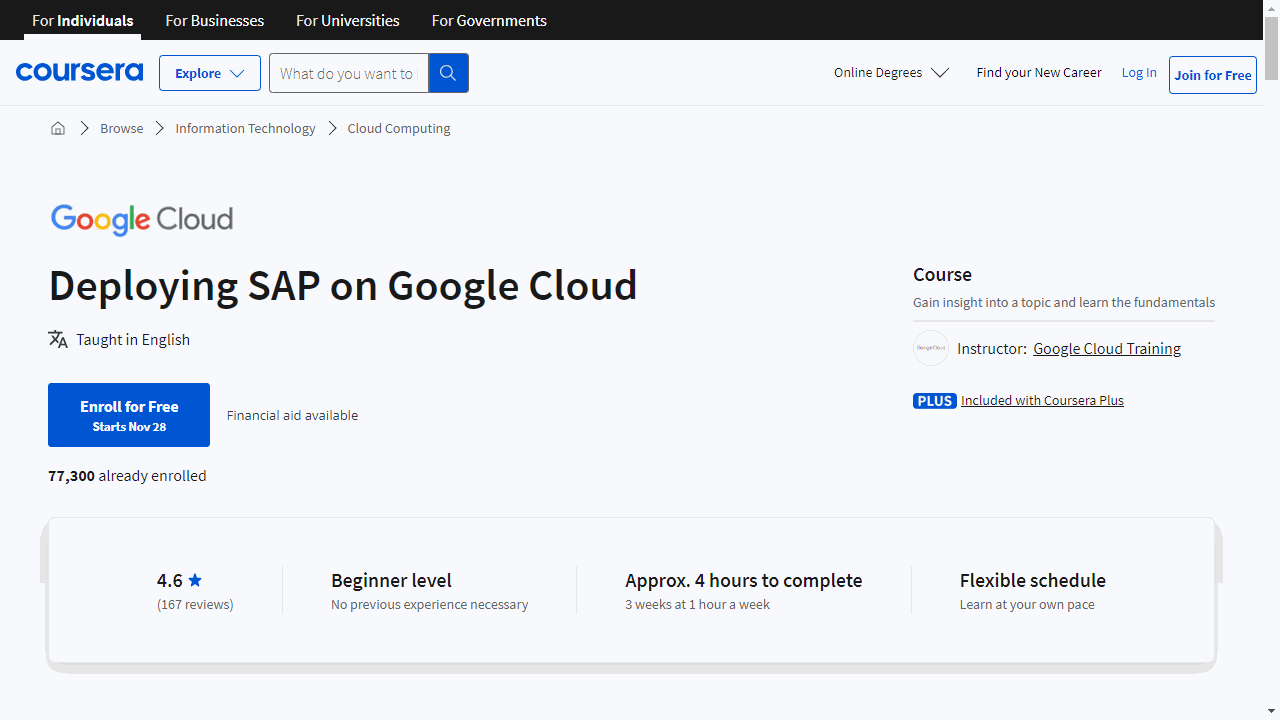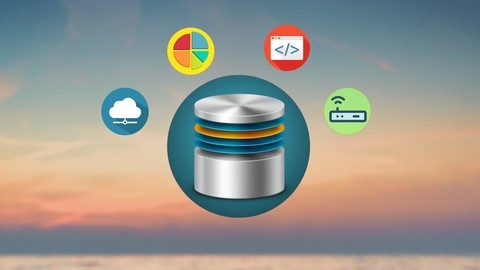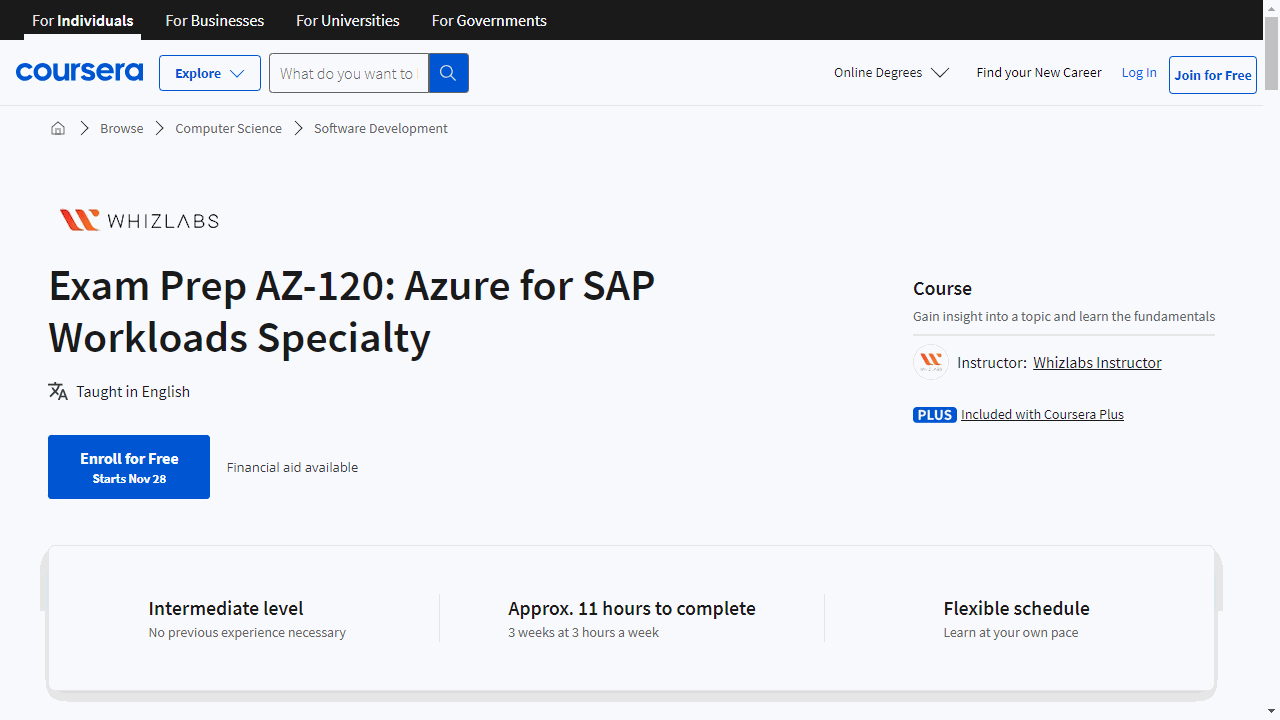SAP (Systems, Applications, and Products in Data Processing) is a leading enterprise resource planning (ERP) software used by businesses worldwide to manage various aspects of their operations, including finance, human resources, supply chain, and customer relationship management.
Learning SAP can open doors to a wide range of lucrative career opportunities in various industries, as companies constantly seek skilled professionals to implement, maintain, and customize their SAP systems.
By gaining SAP expertise, you can become a valuable asset to organizations looking to streamline their processes and improve efficiency.
Finding the right SAP course can be overwhelming, with numerous options available online.
You’re searching for a program that provides a comprehensive understanding of SAP’s core functionalities, offers hands-on experience, and is taught by industry experts who can guide you through the complexities of this powerful software.
For the best SAP course overall, we recommend the SAP Technology Consultant Professional Certificate on Coursera.
This comprehensive program covers everything from the fundamentals of SAP to advanced concepts like system design, development, and customer engagement.
Taught by experienced SAP professionals, it equips you with the practical skills and knowledge needed to succeed in an SAP-focused role.
While this is our top recommendation, there are other excellent SAP courses available that cater to specific interests and career goals.
Whether you’re interested in SAP programming, functional modules, or cloud-based solutions, we have curated a list of top-notch courses to help you find the perfect fit.
Continue reading to explore these options and embark on your SAP learning journey.
SAP Technology Consultant Professional Certificate
Provider: Coursera
The SAP Technology Consultant Professional Certificate on Coursera thoroughly explains what it takes to be successful in the field of SAP, from your first client interaction to implementing the final solution.
You will begin by exploring the SAP ecosystem and the diverse roles within it, such as functional and technical consultants.
You will learn about crucial skills like business process analysis and systems design thinking, along with different project management styles like Waterfall and Agile.
Next, you will dive into the technical side, learning about business processes, organizational structures, and how systems are designed and developed.
You’ll explore different computing models, including cloud and on-premise systems, and gain a solid understanding of the SAP platform.
You’ll become familiar with key development and deployment models, such as ABAP, Java, SAP API, and SAP Fiori.
The program then shifts to the customer engagement aspect, teaching you how to use the SAP Activate methodology to work with clients and help them achieve their goals.
You will learn how to gather information, understand a client’s needs, conduct discovery workshops, and present solutions effectively.
You’ll then learn to turn business requirements into technical solutions.
You’ll learn how to use tools like the SAP Best Practice Explorer and handle issues that arise during the testing and implementation phases.
The program culminates with a hands-on project where you’ll tackle a real-world problem, applying what you’ve learned throughout the program.
This project will allow you to build a portfolio demonstrating your practical experience, which can be incredibly valuable when applying for jobs.
Finally, the program guides you through the next steps to becoming a certified SAP professional.
You will discover different industry applications for SAP solutions, learn about relevant certifications, and create your own personalized career development plan.
SAP Simplified for Absolute Beginners
Provider: Udemy
This course is designed for you if you have no prior experience with SAP.
You’ll begin by learning what SAP is and why it’s important in the business world.
The course introduces you to Enterprise Resource Planning (ERP) and its role in managing business processes.
You’ll then explore the SAP Graphical User Interface (GUI), the system used to interact with SAP software.
The course delves into essential SAP concepts such as Master Data and Transactional Data, explaining how this data is created, used, and managed within the system.
You’ll learn about important SAP components, including the Client-Server Model, which describes how your computer communicates with the SAP server, and the SAP System Landscape, which demonstrates the organization of a live SAP environment.
You’ll get hands-on experience with practical exercises such as creating a Purchase Requisition, changing a Customer Master Data Record, and running reports.
You’ll also explore ABAP, the programming language used within SAP, and understand the importance of Authorization and roles in controlling system access.
Finally, the course provides an overview of the different SAP products available, preparing you to explore the diverse world of SAP solutions.
Deploying SAP on Google Cloud
Provider: Coursera
This course teaches you how to deploy SAP applications on Google Cloud.
You begin by learning about Google Cloud’s network setup, security protocols, and how to ensure your SAP applications are secure.
You discover how to use automation for smoother SAP deployment on Google Cloud.
The course introduces Google Cloud services specifically designed for moving SAP to the cloud.
You learn how these services, like Compute Engine and storage options, help run your SAP applications effectively.
You also explore tools to monitor your SAP deployments on Google Cloud, which helps you manage performance and catch potential issues early on.
You then explore the best ways to design and structure your SAP applications on Google Cloud.
This includes finding the right instance type for your needs and understanding how to use different storage options.
You gain valuable skills in building efficient and reliable SAP systems on the Google Cloud platform.
Finally, the course covers how to make sure your SAP applications are always available and protected from disruptions.
You learn techniques to keep your systems running smoothly, even if something goes wrong.
You also explore ways to back up and recover your data to protect against data loss.
SAP S/4HANA Training - in Plain English
Provider: Udemy
The course starts by explaining the basics of SAP S/4HANA, the newest version of SAP’s software for managing business resources.
You’ll discover why old ERP systems are complicated and how S/4HANA’s modern technology makes things simpler and faster.
You’ll also get hands-on experience using a real S/4HANA system to see these concepts in action.
The course introduces you to Fiori, the new user interface for SAP.
You’ll discover how its user-friendly design, role-based access, and consistent layout make working with SAP easier.
You’ll then explore core features such as customer vendor integration (CVI), which combines customer and vendor data, and learn how to use BRF+ (Business Rule Framework Plus) for setting up business rules efficiently.
You’ll then dive into key areas like credit management, pricing, rebates, inventory management, and more, understanding the changes and improvements made in S/4HANA.
The course explains how to migrate to S/4HANA, the different ways to use it (cloud, on-premise, or hybrid), and how to get certified.
You even get access to FAQs and resources like IDES systems for practicing your skills.
Exam Prep AZ-120: Azure for SAP Workloads Specialty
Provider: Coursera
This course prepares you to manage complex SAP systems on Microsoft Azure.
You will discover the strong partnership between Microsoft and SAP and how Azure effectively supports these critical systems.
The course explores specific Azure tools certified for SAP workloads, such as powerful Azure VMs for SAP HANA and the SAP Cloud Appliance Library, ensuring a deep dive into the compatibility of these technologies.
You will gain a comprehensive understanding of SAP products like NetWeaver, S4HANA, and how HANA operates within Azure.
This includes using Azure Site Recovery, the Azure Extension for SAP, and Azure Compute.
The course delves into practical applications such as performance benchmark testing.
You will master the configuration of Azure Networking specifically for these workloads, including complex scenarios involving HANA Large Instances and Azure Identity services.
The course guides you through the intricacies of migrating your SAP systems to Azure.
You learn effective strategies and techniques such as replication methods and the SAP Database Migration Option.
You will be able to configure Load Balancers for both ASCS and HANA instances, as well as set up a Windows VM for SAP Web Dispatcher.
You will also learn to implement vital operational tasks like Azure Backups, Patch Management, and Disaster Recovery using ASR.
This includes cost-saving methods like de-allocating VMs and using vertical scaling for performance optimization.
You will become proficient in monitoring Azure VMs and using the ABAPMETER tool for efficient performance testing.
SAP ABAP Programming For Beginners - Online Training
Provider: Udemy
This SAP ABAP programming course begins by introducing you to the SAP system and the ABAP Workbench, where you will be coding.
You will get a foundational understanding of the system’s architecture and how to navigate its components.
The Data Dictionary, a core element of ABAP, is covered extensively.
You will learn to create and modify database tables, defining their structures and populating them with data, using entities like Domain Values.
You will discover how to use Open-SQL statements, such as INSERT, UPDATE, DELETE, and other key statements to manage your database interactions.
You will dive into the ABAP editor to begin writing your first programs.
You will understand how to declare variables, write ABAP statements, and work with different data types, including character strings, dates, times, and currencies.
The course teaches you valuable debugging skills using tools like breakpoints and watchpoints, essential for identifying and resolving coding errors.
The course delves into the concepts of program flow control using IF statements, CASE statements, and various loop structures, allowing you to control the logic and execution of your ABAP programs.
You’ll discover how to build interactive user selection screens, incorporating elements like parameters, selection options, and text fields to create dynamic user experiences.
As you progress, you’ll master the use of internal tables, a fundamental data structure in ABAP, learning how to populate, manipulate, and utilize them effectively within your programs.
Finally, the course teaches you how to modularize your ABAP programs using includes, procedures, subroutines, and function modules, promoting code reusability and maintainability.
SAP MM Training - in Plain English
Provider: Udemy
This SAP MM training provides a complete understanding of SAP Materials Management, moving from fundamental concepts to practical applications.
You begin by exploring the Procure to Pay (P2P) lifecycle, the backbone of SAP MM.
You gain hands-on experience using the SAP GUI to create Purchase Orders (POs), receive goods, manage invoices, and process vendor payments.
This practical approach quickly builds your confidence in navigating the system.
Next, you delve into the Enterprise Structure, the framework that organizes your company’s data within SAP.
The course then guides you through creating and managing Material Master and Vendor Master data, crucial for accurate procurement processes.
The training extends beyond the basics, covering advanced concepts such as split valuation for inventory, Consumption-based Planning (CBP) for forecasting material needs, and Material Requirements Planning (MRP) for production planning.
You learn about different stock types, navigate stock transfers, execute stock transport orders (STOs), and understand the importance of physical inventory.
You also discover how to configure your SAP MM system, including customizing Document Types, Item Categories, and Account Assignment Categories, tailoring the system to your company’s unique requirements.
Also check our posts on:







